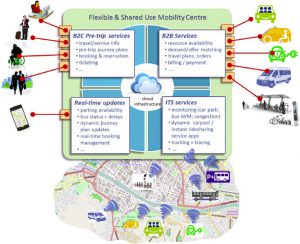By Giorgio Ambrosino, John D. Nelson, Marco Boero, Irene Pettinelli,
(Research in Transportation Economics, Volume 59, November 2016, Pages 179–184)
1. Introduction
Collective transport services have long been seen as an important means for improving sustainable mobility in cities. Currently, over 74% of the EU-28 citizens live in urban areas, a proportion which is expected to exceed 80% by 2030 (EEA, 2013). In 2013, total passenger transport activities in the EU-28 by any motorized means of transport were estimated to amount to 6465 billion pkm or on average around 12,700 km per person (EC, 2015). Currently, the transport sector is responsible for around 23% of total CO2 emissions in Europe and if this trend continues, transport is expected to contribute up to 50% of CO2 emissions by 2050 (EU, 2012). For over two decades increasing efforts have been undertaken to improve local mobility and reduce the negative impacts of traffic in cities and towns across the Europe. A significant number of projects implemented under the European Commission’s CiViTAS and other transport-related programmes (including e.g. IEE, FP7 R&D ICT and Transport framework, Regional Co-operation, etc.) have produced important outcomes ranging from concept exploration to pilot implementation and demonstration (Korver et al., 2012).
However, as stressed by the European Commission in a series of communications (EC, 2009; EC, 2011 ; EC, 2013), new challenges continue to emerge. Among these, climate change, energy consumption, air quality, the difficulties of tackling congestion and accessibility, especially for disadvantaged citizens, are of paramount importance. For these reasons, the priority objective is now to enhance mobility and accessibility while, at the same time, reducing congestion, road accidents and pollution in cities.
In this paper it is contended that such a complex set of problems can only be effectively tackled by adopting an integrated, multimodal and robust set of measures. More sustainable urban mobility, for people and goods, and significant benefits in terms of energy consumption, environmental impacts and quality of the urban environment requires an appropriate mix of interrelated policies and measures. These include: integration between housing policies and transport planning (generally indicated as Transport Oriented Development-TOD); enhancement of public transport efficiency and equity (based on, e.g. more extended and frequent public transport, bus rapid corridors, flexible mobility schemes and feeder services, etc.); promotion of green modes (including pedestrians and bikes) and of “clean” vehicles.
This paper will address the enabling role of technology in encouraging intermodality in urban transport through integration of regular collective transport services with complementary flexible transport schemes and shared-use transport, both public and private.
2. Towards a new understanding of shared transport solutions
It is widely accepted that sustainable urban mobility is unlikely to be achieved without the provision of efficient, extensive and accessible collective transport options (see for example, White, 2017). In the 2011 White Paper (EC, 2011), the European Commission stressed the key role of the public transport sector as a crucial factor for tackling congestion and deteriorating living conditions in urban areas. Considering that bus services are the primary form of public transport both in Europe and globally1 it is evident that the adoption of any effective mobility solution must include this key component. Furthermore, 2014 saw the highest number of local public transport journeys in the EU-28 Member States since the turn of the millennium although this masks significant national variations which are linked with national employment figures (UITP, 2016).
It is well documented that over the past fifty years the operating conditions for conventional bus services have deteriorated. A major challenge is to break the so-called vicious circle whereby increasing motorisation contributes to deteriorating public transport service quality and the further increase of private car use. This is important not only to improve urban mobility, but also to enhance overall city liveability, to reduce pollution and emissions and to promote social inclusion (Banister, 2005). Practical experience (e.g., Korver et al., 2012) has shown that urban areas require robust and efficient mobility solutions which are well integrated in the overall urban planning system and suitable to specific city characteristics. Innovative measures to increase the quality of bus services and strengthen the efficiency of newly emerging mobility schemes are required.
Over the last fifteen years with the support of European funding2 several flexible and demand responsive transport services applications have shown important advantages and benefits in several European cities (Mulley and Nelson, 2016a ; Nelson et al., 2010). Demand Responsive Transport (DRT) services are complementary to the conventional, scheduled passenger transport (fixed lines and timetable), as they usually address dispersed mobility needs, both during hours of low demand and in areas of low population or where target users are dispersed amongst the general population, e.g. disabled and elderly, tourists.
Flexible Transport Services (FTS) can be defined more widely as a transport service which is adapted for meeting users needs, typically on a trip-by-trip basis with a certain level of flexibility on three operational dimensions (routing, timing of the service, vehicle used) in order to enhance service offer and minimize costs in response to demand. FTS include a larger range of services and schemes, such as: general use and feeder services, local and feeder services to trunk haul services, replacement of low-frequency conventional services, replacement of fixed routes in evenings, weekends and other low-demand periods, dedicated/special services restricted to specific users groups, services in low-density rural areas, services designed for efficiencies in social mobility resources, niche urban markets, etc. These different operational schemes have been validated and evaluated from their feasibility and technology aspects to the organization and business models, with different levels of implementation and results (Nelson et al., 2010). At a policy level the EC 2007 Green Paper (EC, 2007), recognises that customized (Public Transport) solutions could better serve suburban areas and enhance integration and accessibility and calls for the implementation of Sustainable Urban Transport Plans (SUTPs) as part of Sustainable Urban Mobility Plans (SUMPs).
From the operational point of view, FTS are organized around the concept of a TDC (Travel Dispatch Centre), as the key operational (and technological) resource supporting the management of the main operation steps connected to the service production workflow: the TDC manages users booking requests, journey planning and resource optimization (vehicles and drivers) communicating to the driver the new journey or the variations to the already planned one.
Complementary to these trends, the traditional contrast between collective and individual transport solutions is gradually blurring. In a service-sharing economy where the concept of Mobility as a Service (MaaS) is becoming a concrete market option, new alternatives to public supplied schemes and car ownership are emerging alongside established schemes like collective taxi and demand responsive bus services, bike and car sharing. Dynamic car-sharing schemes (such as Car2Go, DriveNow and Zipcar), dynamic ridesharing services (like BlaBlaCar and Flinc), peer-to-peer transport arrangement schemes (such as Uber, UberPop and Lyft), and brand new forms of “institutionalized hitchhiking” (i.e. RezoPouce) are all examples of this new offer of flexible mobility schemes, complementary to regular (fixed routes and timetable) as well as flexible collective/public transport ( Nelson & Wright, 2016). Of particular relevance is the following significant trend: from merely being the final recipients of transport services, users themselves have gradually become, in recent years, potential mobility service providers.
The emerging term for collective transport services based around the use of private cars is new mobility services (NMS). Kent and Dowling (2016) provide a useful typology for “cars on demand” which they define as a form of transit involving collaborative use of the car which is characterised as largely based around ride/liftsharing and car sharing/car clubs. They draw a distinction between services which are primarily peer-to-peer operation (liftsharing examples include CarMa, ‘Slugging’; car sharing examples include GetAround, Car Next Door, Relay Rides) and those which are primarily commercial operation (liftsharing examples include Uber, Lyft; car sharing examples include Zip Car, GoGet, Zoom). In considering this development Mulley and Nelson (2016b) suggest that it is useful to reflect on whether we are potentially seeing a redefinition of public/collective transport systems and the extent to which NMS may be incorporated within the traditional public transport offer.
The European Commission (EC, 2016) notes that a paradigm change in transportation is expected to take place through the emergence of Mobility as a Service (MaaS), where the service providers could offer travellers easy, flexible, reliable, price-worthy and environmentally sustainable everyday travel, including for example public transport, car-sharing, car leasing and road use, as well as more efficient goods shipping and delivery possibilities. Crucially, they note that there is not yet quantifiable evidence on the costs and benefits of MaaS, as well as on its influence on travel patterns and behaviour of the end users and this is an urgent area for further research. From a still limited literature MaaS is variously defined but the essential idea is to see transport or mobility not as a physical asset to purchase (e.g. a car) but as a single service available on demand and incorporating all transport services from cars to buses to rail (Transport Systems Catapult, 2015). MaaS Global3 is the Finnish Mobility as a Service concept. They define MaaS, as “a way of combining options from different transport providers into a single mobile service, removing the hassle of planning and one-off payments”. In June 2016 MaaS Global launched Whim, an app which gives people instant access to virtually every kind of transport, from car sharing to taxis, buses, trains and bike share. Similar initiatives have been trialled in Gothenburg (Ubigo 4) and proposed for London5 (Kamargianni, Matyas, Li, & Schäfer, 2015).
The continuous and growing success of private and peer-to-peer ridesharing schemes in Europe and North America (Chan & Shaheen, 2012) which is central to the on-going development of MaaS suggests that these modes should be considered as integral components of a truly intermodal urban mobility. However, this important transport resource which is both collective and flexible, needs to be carefully designed and operated to boost integration with new concepts and solutions and conventional public transport, thus bringing a real added-value in terms of mobility, accessibility and environmental sustainability. The contention of this paper is that MasS which, in terms of its limited literature, appears to focus on a changing role for the car should not ignore the crucial role of public transport (both fixed route and flexible) and the organizational role of the flexible mobility Agency.
If a new understanding of shared transport solutions is to be achieved policy-makers, urban and mobility planners and city stakeholders must undertake strong initiatives, by adopting a multimodal and integrated approach, customized to their specific local context. In particular, this approach should take into account a number of key issues:
– conventional (bus-based) public transport systems need to be “requalified” (in terms of frequency, regularity and comfort) to be fully and efficiently exploited;
– new private mobility schemes based on ride-sharing schemes need to be “institutionalized”, embedded in the overall mobility offer, planned and integrated with public transport services;
– the different ITS systems should be planned and developed within a “city approach”, ideally managed by a single entity (probably although not necessarily a Public Transport Authority) and based on specific local requirements.
This scenario requires strong co-ordination and interoperability among the different mobility services, co-operation among the different actors and stakeholders involved in the transport network, and the integration of information, systems and operations at various levels in a clear framework of policies and organisational measures. Such a move is also consistent with a recent contribution by White (2014) who urges identification of the appropriate roles of both improved ‘conventional’ public transport (interurban routes etc.) and demand responsive and similar services in the collective mobility offer.
3. The Flexible and Shared Use Mobility Centre: concept and approach
Almost all of the FTS applications in Europe have been – or still are – operated as a single mode, by a single operator, and as a single element of a potentially larger intermodal transport chain. Moreover, in urban and metropolitan areas, FTS have been often applied with little or no integration at all with other transport modes and mobility schemes. Starting from this context the concept of the Flexible Transport Agency has been developed and demonstrated (mainly in the EU FAMS and FLIPPER projects6; Ambrosino et al., 2004; Ambrosino et al., 2010 ; Nelson et al., 2010) based on the vision that all actors in the FTS service chain constitute a “Open Community” which can be managed through an appropriate open web architecture and cloud connectivity.7 The different “actors” of the community can be connected and can collaborate at different levels with respect to its specific role (i.e. transport operators can obtain several benefits including: integrated booking opportunities, data and computing services sharing, improved access to information and services, improved offer, enhanced management of the workflow among the transport service providers).
Notwithstanding the physical location of the operators, the different types of fleet/garage, booking systems, services provided, etc., the “Agency” manages the entire service chain – from customer booking to service planning, monitoring and control – operating as a unique “open” entity, as “one operator with one fleet and one booking system”, providing an effective response to the mobility needs of the different users groups.
The approach proposed in this paper focuses on the need to reconcile and enhance the two parallel axes of urban mobility (collective transport and personal mobility) by testing and demonstrating different innovative mobility solutions to be integrated under the “umbrella” of the Flexible and Shared Use Mobility Centre (FSUM), a centre for planning and managing the range of sustainable urban mobility services and which is suitable for the delivery of MaaS.
The approach does not call for “new complex solutions” and heavy investments, but rather for cost-effective and results-oriented measures. The goal is to enhance the quality and efficiency of urban mobility systems, by promoting a “quality evolution” of the conventional public transport services (and potentially an enhanced market share), fully integrated with new (green) mobility solutions and sharing schemes, thus enabling efficient investments and implementation times, flexibility in service operation, positive impacts in energy efficiency, environment quality and urban regeneration possibilities.
3.1. The role of ICT in enabling innovative service concepts
Starting with the premise that ICTs are making it possible to implement innovative services that can improve the cost-effectiveness of FTS, the role of ICT (from open data and cloud solutions to mobile connections and social media networking) can be seen as one of the main aspects for improving not only the cost–effectiveness of such services but also for enforcing their contribution to social inclusion. Yet, knowledge of past experiences and applications (especially in Europe and US) shows that technology is often used for simplifying the complexity of the problems (i.e. the needs of citizens and resources) and tends to be considered as the overall solution. Therefore it is important to analyze and define not only the contribution that the ICT can provide to FTS management, but also to identify the support conditions (i.e. organization and management) for successfully implementing the appropriate ICT tools.
One of the common issues emerging is the importance of keeping the role of ICT in the overall FTS system management and service provision simple. For the system architecture this means a consolidated central software platform that is able to support all relevant FTS functions (from booking and trip planning/assignment to the reporting and accountability) but also to co-ordinate the different actors involved in the service provision. In this context, recent ICT innovations could play a relevant role in increasing the overall information and accessibility of the user with respect to the single FTS service and also other public transport service options.
As technology becomes more integral to the future evolution of FTS, particularly those using Mobility Management concepts involving multiple organizations and their (often different) software applications in a common scheme for providing transportation services to a diverse set of organizations and individuals, the issue of what is included in the core technology infrastructure becomes increasingly important. System architectures, technology platforms, and data standards increasingly determine what is possible to accomplish with FTS schemes designed to serve multiple entities and their riders. Only if the technology foundations are sufficient is it possible to implement innovations that improve the reach and cost-effectiveness of services. It is clear that common data standards and robust technology-based service platforms and architectures are needed for the technology benefits to proliferate rapidly in the FTS sector (O’Neill & Teal, 2013).
A key aspect that emerges is the awareness that ICT could also have a crucial role in (re)positioning FTS as one of the key components of the overall public transport service offer by also incorporating personal mobility solutions, in particular in:
• confirming the holistic approach of many implemented FTS as a key component of the MaaS offer;
• the co-ordination among the different services and actors both from the operation side and from citizens accessibility point of view;
• the integration and interoperability with other public transport service services and systems (at a minimum AVL and ticketing systems) and the newly emerging privately organized shared transport;
• the provision of high-level user accessibility by social media and web facilities; and
• through constant service promotion by focused campaigns and by using social media and existing data bases.
This approach is discussed below.
3.2. The FSUM concept
Fostering the interaction between public and private mobility through various connected mobility schemes (parking, P + R, interchange facilities with shared vehicles schemes, integrated payment, etc.) is pivotal for improving urban mobility as a whole. To achieve seamless integration between collective and private sustainable mobility the FSUM will work on three interrelated levels (collective transport, personal mobility and connected systems) based on the concept of the FSUM centre. The FSUM centre will offer integrated access to several “on demand and shared” individual and collective services, by co-ordinated management of the various actors and services through an ad-hoc organization framework, technology-enabled services and soft measures. In this way the emerging ridesharing services may be considered as part of the wider range of FTS and integrated within the overall public transport offer: increasingly conventional public transport will serve main urban axes/corridors and FTS/ridesharing services will integrate it for feeder, last mile and target groups services. Consequently the Public Transport Authorities and operators must lead on MaaS initiatives, especially in small and medium sized urban areas. This role can be deployed through the introduction of a Shared Mobility Centre as an “umbrella” platform/organization able to co-ordinate conventional different transport services in a seamless mobility offer.
The enabling technological component for the Agency is an ICT infrastructure, based on the emerging paradigm of the Internet of Services, providing several core facilities including: (1) services for transport users (Business-to-Consumer (B2C) services) enabling access to information, search for transport options, travel planning, booking, ticketing; (2) services for the co-ordination of different transport and mobility schemes and the interaction with the relevant operators (Business-to-Business (B2B) services); and (3) services supporting the interactions among different authorities and entities involved in the control of transport services (Business-to-Administration (B2A) services).
The FSUM will be able to support various tasks, including:
– connecting different mobility services with each other (conventional, ride-sharing services, etc.) and to the main regular public transport network/axes, and integrating these with other public transport modes (mainly railway and extra-urban services). This will allow the integrated design of conventional public transport services with the FTS and ride-sharing services;
– providing real-time quality information and services enabling users to plan their trips, adapt travel choices in case of need (e.g. service changes, disruptions, etc.), providing feedback messages and information to the FSUM (on e.g. perceived quality of service, delay or disruptions, etc.) that will help improve service management and provision;
– enhancing users accessibility to interchange nodes and feeder services (i.e. parking areas, bike-sharing stations, etc.);
– Managing common payment tools and clearing procedure and offering Integrated Booking
– serving a niche market of mobility demand (night period, week-end, special user groups, etc.);
– integrating other city mobility services (taxis, logistics services, special services to leisure destinations, etc);
– supporting real co-operation with other operators (not only on transport services but also on B2A services or back-office services, shared software, etc.); and
– integrating the overall FTS and shared mobility system with local mobility policies and operation schemes. This will include making data certification and service validation with respect to the service contract.
Fig. 1 offers an outline of the conceptual architecture for the Flexible and Shared Use Mobility Centre.
Fig. 1 Conceptual architecture of the Flexible and Shared Use Mobility Centre (FSUM).

In work completed as part of the EC-funded LIFE + PERHT project the core role of the FSUM has been designed, adapted and tested in real environments to support different mobility services, from high capacity/quality public transport schemes (like Buses with a High Level of Service – BHLS), regular and flexible collective services, to open, emerging forms of personal ride sharing mobility services as last mile services. The core concept of the FSUM has been investigated and adapted to local policy objectives, stakeholder requirements, users’ needs and mobility market opportunities, leading to local implementations co-ordinating a range of different measures.
PERHT, “Parking Green Services for Better Environment in Historic Towns”, a pilot project part-funded by the EC under the LIFE + Programme (2012–2016), addressed the issue of co-ordinated mobility services for passengers and goods mobility.8 PERHT designed and implemented a “hub for green urban mobility services” in order:
- To reduce the impacts of car traffic through the adoption of innovative eco-sustainable mobility services/measures integrated with the whole urban mobility offer in Treviso, Italy (in particular with the parking management system) and with the current collective mobility services;
- To support the modal shift from car to a series of alternative individual and collective sustainable mobility services;
- To reduce the impacts of commercial traffic, by providing dedicated parking facilities (e.g. freight loading/unloading areas with dynamic reservation, micro-hub services, etc.), integrated with the overall parking management scheme; and
- To promote and foster the electric mobility for both people and goods.
To reach these objectives, the PERHT reference scheme implemented and demonstrated packages of services based around people (Park and Ride with public transport and bike sharing and shared taxis); and goods (co-ordinated deliveries, use of electric vehicles). Service integration and co-ordination was supported by user information services provided via a web portal and on-street information points. Parking resources were specifically recognised as a high value asset to leverage new sustainable services for people and goods mobility and the project has demonstrated that parking services can become a strategic tool for the integrated management of mobility when managed alongside measures such as pedestrian areas, Access Control Zones, Park + Ride etc.
The adoption of the PERHT reference scheme has lead to relevant improvements in terms of energy saving, the urban environment and quality of life in the inner historical centre of Treviso. In this context a mobile app “TREVIMOVE” has been developed and allows an integrated access to all the mobility services with common payment. TREVIMOVE currently has more than 6000 users and is considered the first step of towards the realization of a personalised approach to MaaS in small and medium towns such as Treviso (population 80,000). To manage TREVIMOVE a specific integrated data layer has been developed in order to collect and certify the single data (coming from the different implemented systems and services); this is the first component of the related ICT platform that will be the base for managing the FSUM centre.
Read the full paper at: http://www.sciencedirect.com/science/article/pii/S0739885915301086


















Leave a Reply